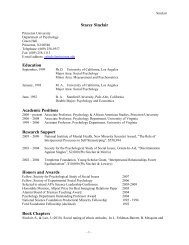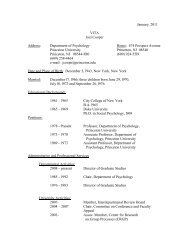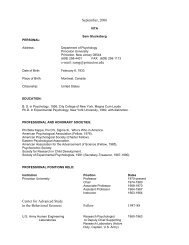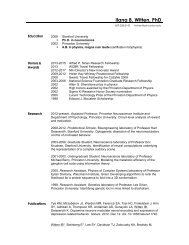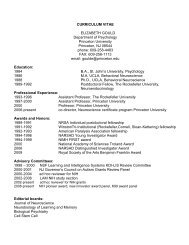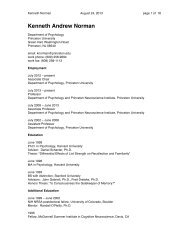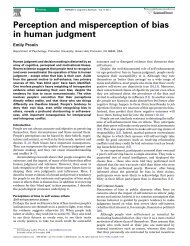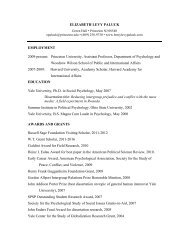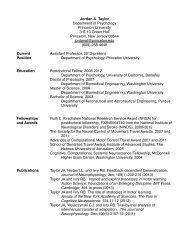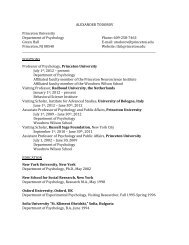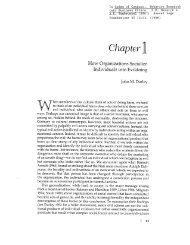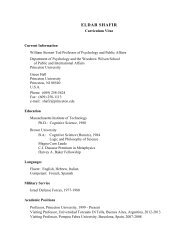and the problems of conditional reasoning - Department of Psychology
and the problems of conditional reasoning - Department of Psychology
and the problems of conditional reasoning - Department of Psychology
Create successful ePaper yourself
Turn your PDF publications into a flip-book with our unique Google optimized e-Paper software.
Opinion‘If’ <strong>and</strong> <strong>the</strong> <strong>problems</strong> <strong>of</strong> <strong>conditional</strong><strong>reasoning</strong>Ruth M.J. Byrne 1 <strong>and</strong> P.N. Johnson-Laird 21 School <strong>of</strong> <strong>Psychology</strong> <strong>and</strong> Institute <strong>of</strong> Neuroscience, Lloyd Building, Trinity College Dublin, University <strong>of</strong> Dublin, Dublin 2, Irel<strong>and</strong>2 <strong>Psychology</strong> <strong>Department</strong>, Green Hall, Princeton University, Princeton, New Jersey, 08544, USA‘If’ is a puzzle. No consensus has existed about itsmeaning for over two thous<strong>and</strong> years. Here, we showhow <strong>the</strong> main psychological <strong>the</strong>ories deal with <strong>the</strong>seven crucial <strong>problems</strong> that it raises. These competingexplanations treat ‘if’ as though it was a term in a formallogic, or as eliciting <strong>the</strong> construction <strong>of</strong> a mental model<strong>of</strong> <strong>the</strong> world, or as an instruction to suppose that aproposition holds. The solution to ‘if’ would be a majorstep towards underst<strong>and</strong>ing how people reason, <strong>and</strong>towards implementing a computer program that canreason in a human way. We argue that <strong>the</strong> mental model<strong>the</strong>ory is closer to resolving <strong>the</strong> puzzle <strong>of</strong> ‘if’ than itscompetitors.IntroductionWhen John F. Kennedy addressed <strong>the</strong> Irish parliament, hesaid:If this nation had achieved its present political <strong>and</strong>economic stature a century or so ago, my great-gr<strong>and</strong>fa<strong>the</strong>rmight never have left New Ross ..Like Kennedy, you can think hypo<strong>the</strong>tically. Youunderst<strong>and</strong> ‘if’ <strong>and</strong> draw inferences from <strong>the</strong> <strong>conditional</strong>assertions that it makes, <strong>and</strong> nei<strong>the</strong>r task seems difficult.Yet for millennia, no agreement has existed about<strong>the</strong> meaning <strong>of</strong> <strong>conditional</strong>s or about <strong>the</strong>ir logical properties.Now, following intensive experimental <strong>and</strong> <strong>the</strong>oreticalefforts, cognitive scientists seem closer todiscovering <strong>the</strong> truth about ‘if’. Here, we outline seven<strong>problems</strong> that any <strong>the</strong>ory <strong>of</strong> <strong>conditional</strong>s must solve, <strong>and</strong>we outline <strong>the</strong> solutions <strong>of</strong>fered by each <strong>of</strong> three mainsorts <strong>of</strong> <strong>the</strong>ory. They are <strong>the</strong>ories based on formal logic,on mental models <strong>of</strong> <strong>the</strong> world <strong>and</strong> on <strong>the</strong> idea that ‘if’invites you to make a supposition. We argue that <strong>the</strong>mental model <strong>the</strong>ory is most likely to solve <strong>the</strong> puzzle <strong>of</strong><strong>conditional</strong>s: it explains <strong>the</strong> factors that affect <strong>reasoning</strong>from <strong>conditional</strong>s, what <strong>the</strong>y mean, <strong>the</strong>ir truth or falsity,<strong>the</strong>ir counterfactual use, <strong>the</strong>ir denials <strong>and</strong> <strong>the</strong>ir probabilities.Problem 1: why are some <strong>conditional</strong> inferencesdifficult?Psychologists study four st<strong>and</strong>ard inferences exemplifiedin Table 1. Consider this one:Corresponding author: Byrne, R.M.J. (rmbyrne@tcd.ie).If he spoke <strong>the</strong>n she laughed.He spoke.What follows?The conclusion is obvious: she laughed. This affirmativeinference is ‘valid’, that is, its conclusion holds in everypossibility in which its premises hold [1], <strong>and</strong> so if itspremises are true <strong>the</strong>n its conclusion is too.By contrast, this negative inference is harder:If he spoke <strong>the</strong>n she laughed.She didn’t laugh.What follows?A typical error is to respond, nothing follows [2], but avalid conclusion is: he didn’t speak. This difference indifficulty is very robust <strong>and</strong> all <strong>the</strong>ories <strong>of</strong> <strong>conditional</strong>sexplain it.Theories based on formal logic, as Box 1 shows, explain<strong>the</strong> difference: <strong>the</strong>re is a formal rule <strong>of</strong> inference for <strong>the</strong>affirmative inference, but not for <strong>the</strong> negative one. Themental model <strong>the</strong>ory, as Box 2 shows, explains <strong>the</strong> difference:mental models represent <strong>the</strong> possibility needed for <strong>the</strong>affirmative inference, but not <strong>the</strong> possibility needed for <strong>the</strong>negative inference. And <strong>the</strong> <strong>the</strong>ory based on suppositions, asBox 3 shows, explains <strong>the</strong> difference: <strong>the</strong> suppositionrepresents <strong>the</strong> case needed for <strong>the</strong> affirmative inference,but not <strong>the</strong> case needed for <strong>the</strong> negative inference.Problem 2: what do <strong>conditional</strong>s mean?Conditionals mean many things [3]. Suppose someone tellsyou: if <strong>the</strong> shelf collapsed <strong>the</strong>n someone put a heavy objecton it. You infer that <strong>the</strong> event in <strong>the</strong> <strong>the</strong>n-clause occurred‘before’ <strong>the</strong> event in <strong>the</strong> if-clause. O<strong>the</strong>r <strong>conditional</strong>sconvey <strong>the</strong> opposite temporal order. Formal rule <strong>the</strong>ories(Box 1) take <strong>the</strong> meaning <strong>of</strong> <strong>conditional</strong>s to be implicit in<strong>the</strong> inferences that follow from <strong>the</strong>m. However, <strong>the</strong>ir rulesyield too few sorts <strong>of</strong> inference (e.g. <strong>the</strong>y do not account for<strong>the</strong> inference above). One solution is to posit more than oneformal logic in <strong>the</strong> mind, but now <strong>the</strong> problem is to match a<strong>conditional</strong> to its appropriate logic. This problem itself callsfor <strong>reasoning</strong> [4].You can envisage <strong>the</strong> possibilities to which a basic<strong>conditional</strong> refers, for example: if he laughed <strong>the</strong>n heremembered. Children tend to list just a single possibility,he laughed <strong>and</strong> remembered; young adolescents list thispossibility <strong>and</strong> a second one, he didn’t laugh <strong>and</strong> didn’tremember; <strong>and</strong> older adolescents <strong>and</strong> adults list <strong>the</strong>se282 1364-6613/$ – see front matter ß 2009 Elsevier Ltd. All rights reserved. doi:10.1016/j.tics.2009.04.003 Available online 18 June 2009
Opinion Trends in Cognitive Sciences Vol.13 No.7Box 3. Suppositional <strong>the</strong>ories <strong>and</strong> <strong>the</strong> probability <strong>of</strong><strong>conditional</strong>sTailor-made for <strong>conditional</strong>s alone, <strong>and</strong> based on Ramsey’s test (seemain text), <strong>the</strong>se <strong>the</strong>ories posit that <strong>conditional</strong>s elicit suppositionalthinking (i.e. you suppose that <strong>the</strong> if-clause is true, <strong>and</strong> think about <strong>the</strong>consequences) [6,7,40,48]. One consequence might be that you reacha contradiction, <strong>and</strong> so accordingly you can reject your supposition.This idea is common to formal rule <strong>the</strong>ories, which invoke <strong>the</strong> rule <strong>of</strong>reductio ad absurdum, <strong>and</strong> to <strong>the</strong> model <strong>the</strong>ory, which relies onmodels to make <strong>the</strong> same inference [3]. But, according to suppositional<strong>the</strong>ories, you also use suppositions to estimate <strong>the</strong> probability<strong>of</strong> a <strong>conditional</strong> [6,7] (c.f. Ref. [30]). The probability <strong>of</strong> <strong>the</strong> <strong>conditional</strong>:If <strong>the</strong> dice came down with an even number uppermost <strong>the</strong>n itcame down 6.is <strong>the</strong> ‘<strong>conditional</strong> probability’ <strong>of</strong> a 6 given that <strong>the</strong> dice l<strong>and</strong>ed with aneven number. Given a fair dice, this probability is 1/3. The same ideaapplies even when you use indirect evidence to estimate <strong>the</strong>probability that, say, if Obama’s policies work <strong>the</strong>n he’ll be re-elected.Some authors have gone even fur<strong>the</strong>r, <strong>and</strong> argued that <strong>the</strong> meaning <strong>of</strong>a <strong>conditional</strong> in an everyday context is a <strong>conditional</strong> probability [31].One suppositional <strong>the</strong>ory postulates a ‘singularity principle’ thatyou make only a single mental simulation [6]. Given, say, <strong>the</strong><strong>conditional</strong>, ‘If Paul wins <strong>the</strong> lottery <strong>the</strong>n he’ll buy a Ferrari’, yousimulate Paul winning <strong>the</strong> lottery <strong>and</strong> assess <strong>the</strong> believability <strong>of</strong> himbuying <strong>the</strong> Ferrari. You represent <strong>the</strong> strength <strong>of</strong> your belief as aThe premise is undoubtedly true, <strong>and</strong> so according to <strong>the</strong>defective truth table <strong>the</strong> inference is valid because <strong>the</strong> onlyway <strong>the</strong> premise can be true is if its if-clause is true too [9].The inference is absurd; <strong>and</strong> so too is <strong>the</strong> defective truthtable. The judgments <strong>of</strong> irrelevance that it reflects occurbecause individuals tend to underst<strong>and</strong>:In what cases is it true that if that happens <strong>the</strong>n thishappens?as meaning:If that happens <strong>the</strong>n in what circumstances is it truethat this happens?They mistakenly evaluate, not <strong>the</strong> truth <strong>of</strong> <strong>the</strong> <strong>conditional</strong>,but <strong>the</strong> truth <strong>of</strong> its consequent given that itsantecedent holds.Problem 4: why is <strong>reasoning</strong> with if <strong>and</strong> only if easier?The phrase, ‘if <strong>and</strong> only if’, seems like something that only alawyer or logician would say, but consider this inference[3]:If <strong>and</strong> only if he spoke <strong>the</strong>n she laughed.She didn’t laugh.What follows?You should find it easier to infer that he did not speakthan <strong>the</strong> negative inference that you made in <strong>the</strong> firstsection. Similarly, consider this inference:He yawned only if she did.She didn’t yawn.What follows?Again, you should find it easy to infer that he did notyawn. What explains <strong>the</strong>se two robust results [3,10,11]?The model <strong>the</strong>ory predicts <strong>the</strong>m in <strong>the</strong> following way [3].You normally think only about <strong>the</strong> possibility in which bothclauses <strong>of</strong> a <strong>conditional</strong> hold. Only if makes you also think<strong>of</strong> <strong>the</strong> negative possibility in which nei<strong>the</strong>r clause holds(e.g. he didn’t yawn <strong>and</strong> she didn’t yawn). And it is thispossibility that you need to make <strong>the</strong> negative inference.Formal rule <strong>the</strong>ories <strong>and</strong> <strong>the</strong> suppositional <strong>the</strong>ory <strong>of</strong>fer noimmediate explanation <strong>of</strong> <strong>the</strong> phenomena. They mightpostulate that both <strong>conditional</strong>s have <strong>the</strong> logical form <strong>of</strong>:If A <strong>the</strong>n B, <strong>and</strong> if not-B <strong>the</strong>n not-A. The second clauseenables <strong>the</strong> negative inference to be made at once. But, howindividuals recover this logical form – or indeed any logicalform – remains a mystery. Meta-analyses <strong>and</strong> <strong>the</strong> closefitting <strong>of</strong> <strong>the</strong> three <strong>the</strong>ories to data have shown that<strong>the</strong> model <strong>the</strong>ory provides a better account <strong>of</strong> <strong>the</strong>st<strong>and</strong>ard inferences in Table 1 than <strong>the</strong> o<strong>the</strong>r two <strong>the</strong>ories[12–14].Problem 5: what makes counterfactuals special?Kennedy’s <strong>conditional</strong> at <strong>the</strong> start <strong>of</strong> this article refers to apossibility that did not actually occur – Irel<strong>and</strong> was stillstruggling for independence a century before he spoke.Such ‘counterfactual’ <strong>conditional</strong>s are common in everydaydiscourse [15–18], but <strong>the</strong>y differ in meaning <strong>and</strong> inferentialconsequences from <strong>the</strong> <strong>conditional</strong>s that we have discussedso far. Counterfactuals, as <strong>the</strong> model <strong>the</strong>orypostulates, refer to two sorts <strong>of</strong> possibility [3,18]. Onepossibility is factual: Irel<strong>and</strong> had not achieved its presentstature <strong>the</strong>n <strong>and</strong> Kennedy’s great-gr<strong>and</strong>fa<strong>the</strong>r left. Theo<strong>the</strong>r possibility is counterfactual. It is an alternative toreality: <strong>the</strong> nation achieved its present stature a centuryago <strong>and</strong> Kennedy’s great-gr<strong>and</strong>fa<strong>the</strong>r did not leave. Thesetwo possibilities yield a difference in meaning from regular<strong>conditional</strong>s, which refer only to real possibilities. Theregular <strong>conditional</strong>, ‘If Shakespeare didn’t write The Tempest<strong>the</strong>n someone else did’, is true, whereas <strong>the</strong> counterfactual,‘If Shakespeare hadn’t written The Tempest <strong>the</strong>nsomeone else would have’, is debatable – an obviousalternative is that no-one wrote <strong>the</strong> play [17–20]. You tendto represent both <strong>the</strong> factual <strong>and</strong> <strong>the</strong> counterfactual possibilities[21–23], <strong>and</strong> hence a regular <strong>conditional</strong> primesyou to read a description <strong>of</strong> only <strong>the</strong> factual possibility,whereas <strong>the</strong> counterfactual primes you to read descriptions<strong>of</strong> both <strong>the</strong> factual <strong>and</strong> <strong>the</strong> counterfactual possibilities[24,25]. One inferential consequence that <strong>the</strong> model <strong>the</strong>orypredicts is that individuals make <strong>the</strong> valid negative inferencein Table 1 more readily with a counterfactual thanwith a regular <strong>conditional</strong> [18,26]. Nei<strong>the</strong>r formal rule<strong>the</strong>ories nor <strong>the</strong> suppositional <strong>the</strong>ory <strong>of</strong>fer any obviousaccount <strong>of</strong> this result.Problem 6: what denies a <strong>conditional</strong>?Individuals have no clear idea about how to ‘negate’ anassertion, but <strong>the</strong>y do know how to deny one. Some individualsdeny a <strong>conditional</strong> such as, ‘if he spoke <strong>the</strong>n shelaughed’, by asserting: if he spoke <strong>the</strong>n she didn’t laugh;<strong>and</strong> o<strong>the</strong>rs deny it categorically: he spoke <strong>and</strong> she didn’tlaugh [27]. But, which denial is correct? The answer is clearfor a general claim, such as: if any man speaks <strong>the</strong>n awoman laughs. Its denial is at least one man speaks <strong>and</strong> awoman does not laugh (i.e. one counterexample suffices to284
Opinion Trends in Cognitive Sciences Vol.13 No.7show that <strong>the</strong> <strong>conditional</strong> is false [9,28]). Likewise, thiscase is <strong>the</strong> only one that is not possible given <strong>the</strong> meaning<strong>of</strong> <strong>the</strong> <strong>conditional</strong> (Box 2).So, why do some individuals deny one <strong>conditional</strong> withano<strong>the</strong>r <strong>conditional</strong>, <strong>and</strong> why do some <strong>the</strong>orists [27,29]think that this denial is correct? The answer reflects ageneral principle, which we introduced in discussing <strong>the</strong>truth <strong>of</strong> <strong>conditional</strong>s (see earlier). Individuals make lifesimpler for <strong>the</strong>mselves. They underst<strong>and</strong>:What denies if that happens <strong>the</strong>n this happens?as meaning:If that happens <strong>the</strong>n what denies that this happens?They mistakenly envisage, not <strong>the</strong> denial <strong>of</strong> <strong>the</strong> <strong>conditional</strong>,but <strong>the</strong> denial <strong>of</strong> its consequent given its antecedent[9].Problem 7: what is <strong>the</strong> probability <strong>of</strong> a <strong>conditional</strong>?The principle to which we have just alluded also explains<strong>the</strong> answer that individuals give to <strong>the</strong> following sort <strong>of</strong>question:What is <strong>the</strong> probability that if <strong>the</strong> nickel is heads <strong>the</strong>n<strong>the</strong> dime is heads?They interpret <strong>the</strong> question to mean:If <strong>the</strong> nickel is heads <strong>the</strong>n what’s <strong>the</strong> probability that<strong>the</strong> dime is heads?They estimate, not <strong>the</strong> probability <strong>of</strong> <strong>the</strong> <strong>conditional</strong>, but<strong>the</strong> <strong>conditional</strong> probability <strong>of</strong> its consequent given itsantecedent [9]. Formal rule <strong>the</strong>ories do not seem to haveaddressed this question, but several probabilistic <strong>the</strong>ories<strong>of</strong> <strong>reasoning</strong> have postulated that <strong>the</strong> probability <strong>of</strong> a<strong>conditional</strong> is, <strong>and</strong> should be, <strong>the</strong> aforesaid <strong>conditional</strong>probability [30,31]. It is also a consequence <strong>of</strong> <strong>the</strong> suppositional<strong>the</strong>ory [6,7].No-one doubts that some people some <strong>of</strong> <strong>the</strong> time makethis estimate [29,32–34]. But, is it correct? Here is oneargument to <strong>the</strong> contrary, which hinges on this inference:The nickel came down heads or <strong>the</strong> dime came downheads, or both did.Therefore, if <strong>the</strong> nickel didn’t come down heads <strong>the</strong>n<strong>the</strong> dime did.Box 4. Outst<strong>and</strong>ing questions In what circumstances do people express <strong>the</strong>ir thoughts by using‘if’ ra<strong>the</strong>r than ano<strong>the</strong>r connective? Do people ever recover <strong>the</strong> logical form <strong>of</strong> assertions? If so, howdo <strong>the</strong>y do it? How do individuals come up with numerical estimates when <strong>the</strong>yinfer <strong>the</strong> probabilities <strong>of</strong> <strong>conditional</strong>s in an intuitive way from nonnumericalinformation? What factors guide people in <strong>the</strong> development <strong>and</strong> completion <strong>of</strong>‘what if’ thoughts? Do individuals simulate an unfolding temporal sequence <strong>of</strong> eventswhen <strong>the</strong>y underst<strong>and</strong> <strong>conditional</strong>s referring to sequences <strong>of</strong>events?The conclusion holds in exactly <strong>the</strong> same three possibilitiesin which <strong>the</strong> premise holds, <strong>and</strong> so <strong>the</strong> two assertionsshould have <strong>the</strong> same probability. Suppose <strong>the</strong> two coinsare tossed fairly. The first assertion holds in three out <strong>of</strong><strong>the</strong> four equally likely outcomes, <strong>and</strong> so it has a probability<strong>of</strong> 3/4. But, <strong>the</strong> conclusion’s <strong>conditional</strong> probability that <strong>the</strong>dime came down heads given that <strong>the</strong> nickel didn’t comedown heads is only 1/2. Something has gone wrong. And <strong>the</strong>only viable diagnosis is that it is erroneous to assume that<strong>the</strong> <strong>conditional</strong> probability corresponds to <strong>the</strong> probability<strong>of</strong> <strong>the</strong> <strong>conditional</strong>.No-one doubts that some people some <strong>of</strong> <strong>the</strong> time makeo<strong>the</strong>r estimates <strong>of</strong> <strong>the</strong> probability <strong>of</strong> a <strong>conditional</strong> [29,32–34]. The model <strong>the</strong>ory <strong>of</strong>fers an explanation. As in o<strong>the</strong>rforms <strong>of</strong> <strong>reasoning</strong>, different individuals adopt differentstrategies [35,36]. One strategy contrasts <strong>the</strong> single explicitmental model <strong>of</strong> a <strong>conditional</strong> with <strong>the</strong> alternative inwhich <strong>the</strong> <strong>conditional</strong> is false (Box 2). This ‘equiprobable’strategy is analogous to <strong>the</strong> suppositional <strong>the</strong>ory [37,38].Ittoo yields a probability <strong>of</strong> 1/2. A second strategy treats <strong>the</strong><strong>conditional</strong> as though it were a conjunction, again reflectingits single explicit mental model. It yields a probability<strong>of</strong> 1/4. And a third strategy sums <strong>the</strong> probabilities <strong>of</strong> allthree possibilities in which <strong>the</strong> <strong>conditional</strong> holds. It yields aprobability <strong>of</strong> 3/4, which matches <strong>the</strong> required probability<strong>of</strong> <strong>the</strong> premise in <strong>the</strong> inference above.ConclusionsWe have described seven <strong>problems</strong> about <strong>conditional</strong>s thatconcern <strong>the</strong>ir meanings, <strong>the</strong>ir truth or falsity, <strong>the</strong>ir counterfactualuse, <strong>the</strong>ir denials, <strong>the</strong>ir probabilities <strong>and</strong> <strong>the</strong>factors that affect <strong>reasoning</strong> from <strong>the</strong>m. They are not <strong>the</strong>only <strong>problems</strong>, <strong>of</strong> course (Box 4), but any adequate <strong>the</strong>ory <strong>of</strong><strong>conditional</strong>s has to solve <strong>the</strong>m. Table 2 summarizes <strong>the</strong>solutions <strong>of</strong> <strong>the</strong> three main <strong>the</strong>ories.Table 2. The three <strong>the</strong>ories’ solutions to <strong>the</strong> seven <strong>problems</strong> <strong>of</strong> <strong>conditional</strong>sTheoriesFormalrulesProblemsMentalmodelsSuppositions1. Why are some <strong>conditional</strong> inferences difficult? + + +2. What do <strong>conditional</strong>s mean? + ?3. In what cases are <strong>conditional</strong>s true? ? +4. Why is <strong>reasoning</strong> with if <strong>and</strong> only if easier? +5. What makes counterfactuals special? + ?6. What denies a <strong>conditional</strong>? ? + ?7. What is <strong>the</strong> probability <strong>of</strong> a <strong>conditional</strong>? ? + ?+: <strong>the</strong> <strong>the</strong>ory <strong>of</strong>fers a putative solution to <strong>the</strong> problem;.: <strong>the</strong> <strong>the</strong>ory has difficulty in solving <strong>the</strong> problem;.?: <strong>the</strong> <strong>the</strong>ory requires fur<strong>the</strong>r development to solve <strong>the</strong> problem.285
Opinion Trends in Cognitive Sciences Vol.13 No.7Formal rule <strong>the</strong>ories focus on <strong>the</strong> pro<strong>of</strong>s <strong>of</strong> given conclusions.Their biggest problem is <strong>the</strong> lack <strong>of</strong> any comprehensiveaccount <strong>of</strong> <strong>the</strong> logical form <strong>of</strong> assertions: noalgorithm exists for deriving it. As a consequence, <strong>the</strong>se<strong>the</strong>ories fail to deal adequately with <strong>the</strong> meanings <strong>of</strong><strong>conditional</strong>s <strong>and</strong> <strong>the</strong>ir alternative patterns <strong>of</strong> inference.The <strong>the</strong>ories are not designed to address several <strong>of</strong> our<strong>problems</strong>.The suppositional <strong>the</strong>ory focuses on beliefs <strong>and</strong> subjectiveestimates <strong>of</strong> <strong>the</strong> probabilities <strong>of</strong> <strong>conditional</strong>s. Itsbiggest <strong>problems</strong> derive from its emphasis on possibilitiesin which <strong>the</strong> if-clause <strong>of</strong> a <strong>conditional</strong> holds. Thisemphasis leads to dubious claims about <strong>the</strong> defectivetruth table, denials <strong>of</strong> <strong>conditional</strong>s, <strong>and</strong> estimates <strong>of</strong><strong>the</strong>ir probability. The <strong>the</strong>ory resembles <strong>the</strong> model <strong>the</strong>oryin its use <strong>of</strong> representations <strong>of</strong> possibilities. It alsoresembles formal rule <strong>the</strong>ories because its proponentsargue that logical form has a role in <strong>reasoning</strong>. Unlike<strong>the</strong> formal rule <strong>the</strong>ory [39], however, it has yet to beimplemented computationally, <strong>and</strong> so this aspect <strong>of</strong> <strong>the</strong><strong>the</strong>ory might change.The model <strong>the</strong>ory focuses on <strong>the</strong> possibilities to whichassertions refer, <strong>and</strong> uses <strong>the</strong>m to explain <strong>conditional</strong><strong>reasoning</strong>. Recently, we circulated a question to a hundred<strong>reasoning</strong> researchers: what is wrong with <strong>the</strong> model<strong>the</strong>ory? Only a small number <strong>of</strong> <strong>the</strong>m identified putativefailures <strong>of</strong> <strong>the</strong> <strong>the</strong>ory, but <strong>the</strong> majority <strong>of</strong> those who did,criticized its account <strong>of</strong> <strong>conditional</strong>s (<strong>and</strong> <strong>the</strong>reby in partprompted this article). One objection is a conundrum for<strong>the</strong> <strong>the</strong>ory: individuals with a working memory <strong>of</strong> a highcapacity are more likely to treat <strong>conditional</strong>s as though<strong>the</strong>y had a defective truth table than as referring to threepossibilities [40]. Indeed, no single <strong>the</strong>ory has a monopolyon <strong>the</strong> truth. Yet, <strong>the</strong> model <strong>the</strong>ory <strong>of</strong> <strong>conditional</strong>s <strong>and</strong> itscomputational implementations explains <strong>the</strong> <strong>problems</strong>that we have considered here.AcknowledgementThis research was supported in part by National Science FoundationGrant SES 0844851 to <strong>the</strong> second author to study deductive <strong>and</strong>probabilistic <strong>reasoning</strong>.References1 Jeffrey, R.C. (1981) Formal Logic: Its Scope <strong>and</strong> Limits. McGraw-Hill2 Johnson-Laird, P.N. (2006) How We Reason. Oxford UniversityPress3 Johnson-Laird, P.N. <strong>and</strong> Byrne, R.M.J. (2002) Conditionals: a<strong>the</strong>ory <strong>of</strong> meaning, inference, <strong>and</strong> pragmatics. Psychol. Rev. 109,646–6784 Stenning, K. <strong>and</strong> Van Lambalgen, M. (2008) Human Reasoning <strong>and</strong>Cognitive Science. MIT Press5 Barrouillet, P. et al. (2000) Conditional <strong>reasoning</strong> by mentalmodels: chronometric <strong>and</strong> developmental evidence. Cognit. 75, 237–2666 Evans, J.St.B.T. <strong>and</strong> Over, D.E. (2004) If. Oxford University Press7 Evans, J.St.B.T. (2007) Hypo<strong>the</strong>tical Thinking. <strong>Psychology</strong> Press8 Ramsey, F.P. (1990) General propositions <strong>and</strong> causality. InFoundations: Essays in Philosophy, Logic, Ma<strong>the</strong>matics <strong>and</strong>Economics (Mellor, D.H., ed.), pp. 145–163, (Original work published1929.), Humanities Press9 Johnson-Laird, P.N. et al. (2009) The mental model <strong>the</strong>ory <strong>of</strong><strong>conditional</strong>s: A reply to Guy Politzer. Topoi 28, 75–8010 Santamaria, C. <strong>and</strong> Espino, O. (2002) Conditionals <strong>and</strong> directionality:on <strong>the</strong> meaning <strong>of</strong> if versus only if. Q. J. Exp. Psychol. 55A,41–5711 Grosset, N. <strong>and</strong> Barrouillet, P. (2003) On <strong>the</strong> nature <strong>of</strong> mental models <strong>of</strong><strong>conditional</strong>: The case <strong>of</strong> If. If <strong>the</strong>n <strong>and</strong> Only if. Think. Reason. 9, 289–30612 Oberauer, K. (2006) Reasoning with <strong>conditional</strong>s: A test <strong>of</strong> formalmodels <strong>of</strong> four <strong>the</strong>ories. Cognit. Psychol. 53, 238–28313 Espino, O. et al. People think about what is true for <strong>conditional</strong>s,not what is false: Only true possibilities prime <strong>the</strong> comprehension <strong>of</strong>‘‘if’’. Q. J. Exp. Psychol.(in press)14 Schroyens, W. <strong>and</strong> Schaeken, W. (2003) A critique <strong>of</strong> Oaksford, Chater<strong>and</strong> Larkin’s (2000) <strong>conditional</strong> probability model <strong>of</strong> <strong>conditional</strong><strong>reasoning</strong>. J. Exp. Psychol. Learn. Mem. Cogn. 29, 140–14915 M<strong>and</strong>el, D.R. et al., eds (2005) The <strong>Psychology</strong> <strong>of</strong> CounterfactualThinking, Routledge16 Markman, K. et al. (2008) The H<strong>and</strong>book <strong>of</strong> Imagination <strong>and</strong> MentalSimulation. <strong>Psychology</strong> Press17 Byrne, R.M.J. (2002) Mental models <strong>and</strong> counterfactual thoughts aboutwhat might have been. Trends Cogn. Sci. 6, 426–43118 Byrne, R.M.J. (2005) The Rational Imagination: How People CreateAlternatives to Reality. MIT Press19 Bennett, J. (2003) A Philosophical Guide to Conditionals. OxfordUniversity Press20 Williamson, T. (2007) Philosophical knowledge <strong>and</strong> knowledge <strong>of</strong>counterfactuals. In Philosophical Knowledge: Its Possibility <strong>and</strong>Scope (Beyer, C. <strong>and</strong> Burri, A., eds), pp. 89–124, Rodopi21 Ferguson, H.J. <strong>and</strong> Sanford, A.J. (2008) Anomalies in real <strong>and</strong>counterfactual worlds: an eye-movement investigation. J. Mem.Lang. 58, 609–62622 Thompson, V.A. <strong>and</strong> Byrne, R.M.J. (2002) Reasoning about things thatdidn’t happen. J. Exp. Psychol. Learn. Mem. Cogn. 28, 1154–117023 Quelhas, A.C. <strong>and</strong> Byrne, R.M.J. (2003) Reasoning with deontic <strong>and</strong>counterfactual <strong>conditional</strong>s. Think. Reason. 9, 43–6624 Santamaria, C. et al. (2005) Counterfactuals <strong>and</strong> semifactuals primealternative possibilities. J. Exp. Psychol. Learn. Mem. Cogn. 31, 1149–115425 De Vega, M. et al. (2007) Canceling updating in <strong>the</strong> comprehension <strong>of</strong>counterfactuals embedded in narrative. Mem. Cognit. 35, 1410–142126 Byrne, R.M.J. (2007) Precis <strong>of</strong> The Rational Imagination: How PeopleCreate Alternatives to Reality. Behav. Brain Sci. 30, 439–48027 H<strong>and</strong>ley, S.J. et al. (2006) The negated <strong>conditional</strong>: Litmus test for <strong>the</strong>suppositional <strong>conditional</strong>? J. Exp. Psychol. Learn. Mem. Cogn. 13, 378–39528 Byrne, R.M.J. <strong>and</strong> Johnson-Laird, P.N. (2009) Conditionals<strong>and</strong> possibilities. In The <strong>Psychology</strong> <strong>of</strong> Conditionals (Oaksford, M.,ed.), Oxford University Press29 Politzer, G. (2007) Reasoning with <strong>conditional</strong>s. Topoi 26, 76–9530 Oaksford, M. <strong>and</strong> Chater, N. (2007) Bayesian Rationality: TheProbabilistic Approach to Human Reasoning. Oxford University Press31 Pfeifer, N. <strong>and</strong> Kleiter, G.D. (2005) Towards a mental probability logic.Psychol. Belg. 45, 71–9932 Evans, J.St.B.T. et al. (2003) Conditionals <strong>and</strong> <strong>conditional</strong> probability.J. Exp. Psychol. Learn. Mem. Cogn. 29, 321–33533 Oberauer, K. <strong>and</strong> Wilhelm, W. (2003) The meaning(s) <strong>of</strong> <strong>conditional</strong>s:Conditional probability, mental models, <strong>and</strong> personal utilities. J. Exp.Psychol. Learn. Mem. Cogn. 29, 680–69334 Over, D.E. et al. (2007) The probability <strong>of</strong> causal <strong>conditional</strong>s. Cognit.Psychol. 54, 62–9735 Van der Henst, J-B. et al. (2002) Strategies in sentential Reasoning.Cogn. Sci. 26, 425–46836 Lee, N.Y.L. et al. (2008) The psychological problem <strong>of</strong> Sudoku. Think.Reason. 14, 342–36437 Girotto, V. <strong>and</strong> Johnson-Laird, P.N. (2004) The probability <strong>of</strong><strong>conditional</strong>s. Psychologia 47, 207–22538 Girotto, V. <strong>and</strong> Johnson-Laird, P.N. (2008) Conditionals<strong>and</strong> probabilities. In The <strong>Psychology</strong> <strong>of</strong> Conditionals (Oaksford, M.,ed.), Oxford University Press39 Rips, L.J. (1994) The <strong>Psychology</strong> <strong>of</strong> Pro<strong>of</strong>. MIT Press40 Evans, J.St.B.T. et al. (2007) Thinking about <strong>conditional</strong>s: A study <strong>of</strong>individual differences. Mem. Cognit. 35, 1772–178441 O’Brien, D. (2009) Human <strong>reasoning</strong> requires a mental logic. Behav.Brain Sci. 32, 96–9742 Cheng, P.C. <strong>and</strong> Holyoak, K.J. (2008) Pragmatic <strong>reasoning</strong> schemas. InReasoning: studies <strong>of</strong> human inference <strong>and</strong> its foundations (Adler, J.E.<strong>and</strong> Rips, L.J., eds), pp. 827–842, Cambridge University Press43 Cosmides, L.etal. (2005)Detectingcheaters. Trends Cogn. Sci.9, 505–506286
Opinion Trends in Cognitive Sciences Vol.13 No.744 Oberauer, K. et al. (2004) Logical <strong>reasoning</strong> <strong>and</strong> probabilities: Acomprehensive test <strong>of</strong> Oaksford <strong>and</strong> Chater (2001). Psychon. Bull.Rev. 11, 521–52745 Johnson-Laird, P.N. <strong>and</strong> Hasson, U. (2003) Counterexamples insentential <strong>reasoning</strong>. Mem. Cognit. 31, 1105–111346 Schroyens, W. et al. (2003) In search <strong>of</strong> counterexamples: Deductiverationalityinhuman<strong>reasoning</strong>.Quart.J.Exp.Psychol.56(A),1129–114547 Verschueren, N. et al. (2005) Everyday <strong>conditional</strong> <strong>reasoning</strong>: Aworking memory-dependent trade<strong>of</strong>f between counterexample <strong>and</strong>likelihood use. Mem. Cognit. 33, 107–11948 Evans, J.S.T.B.T. et al. (2005) Supposition, extensionality <strong>and</strong><strong>conditional</strong>s: A critique <strong>of</strong> <strong>the</strong> mental model <strong>the</strong>ory <strong>of</strong> Johnson-Laird<strong>and</strong> Byrne (2002). Psychol. Rev. 112, 1042–1052287



